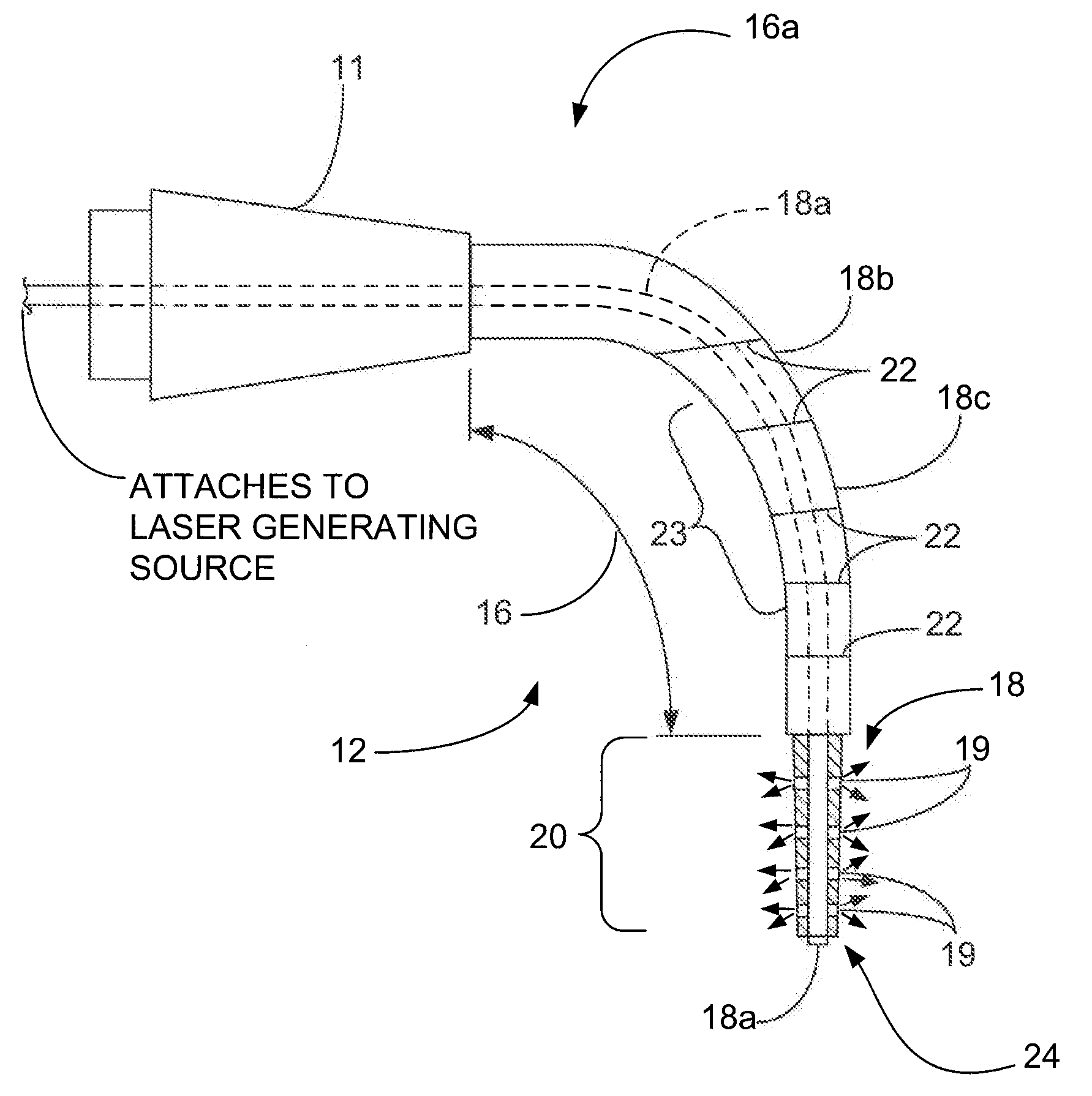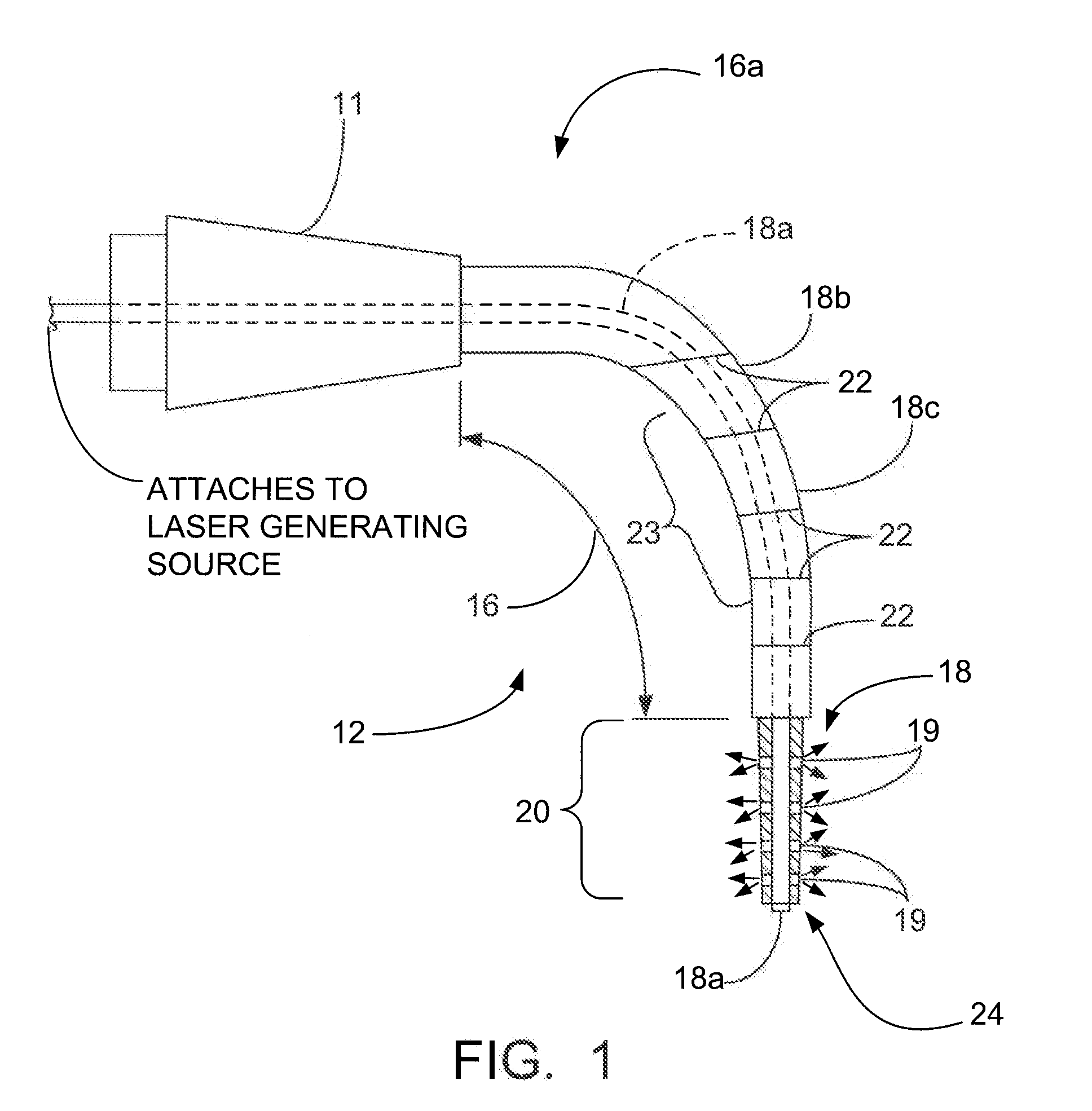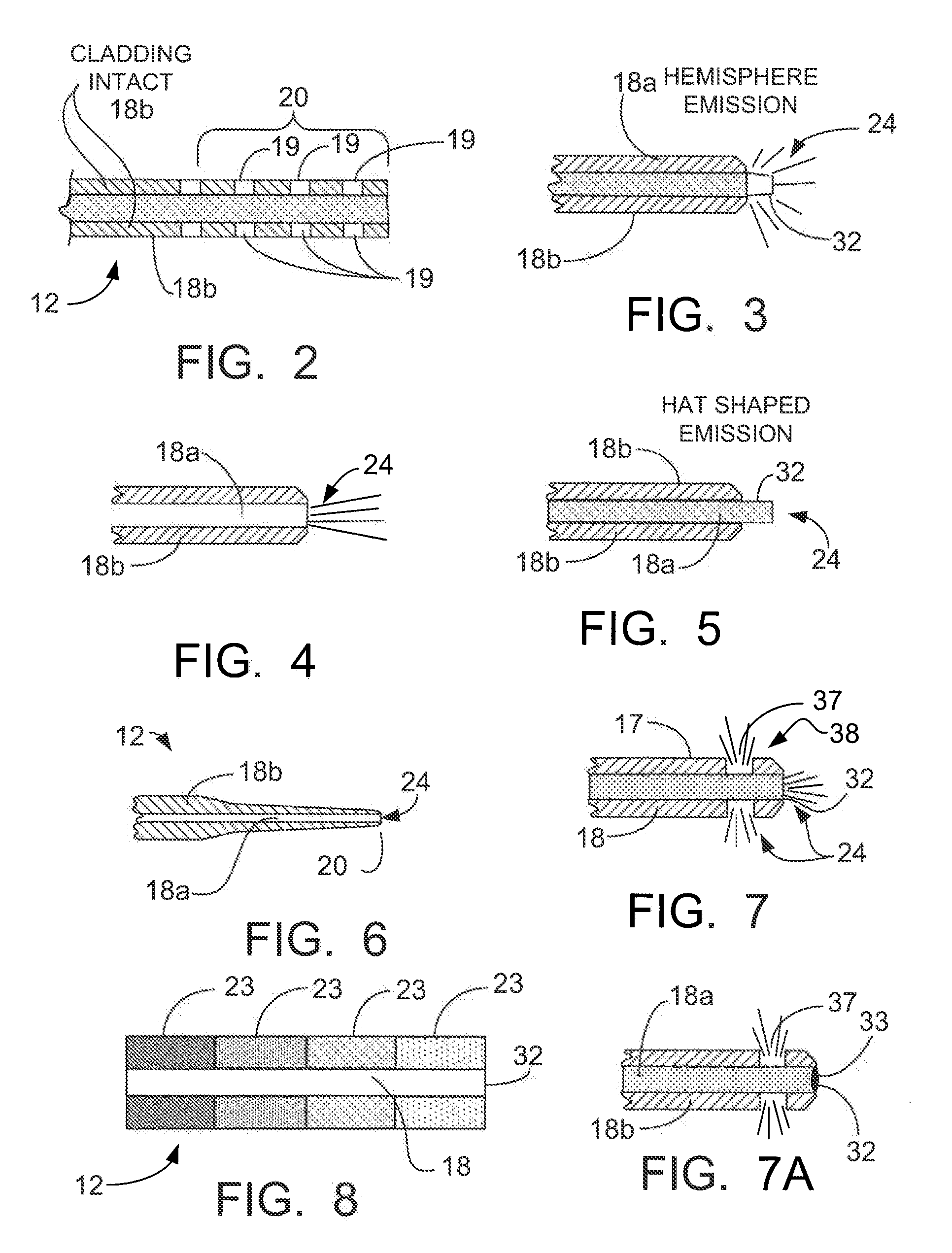[0049]
Diode lasers are very different from FRP lasers. FRP lasers generate very
high peak powers in very short time periods which allow for heat dissipation.
Diode lasers do not. The generation of heat with a
diode laser during treatment is a significant clinical consideration. FRP lasers may be used to remove tissue essentially without constraints of time or heat buildup and subsequent
tissue damage while the
diode laser cannot.
[0051]Because of the differences previously described, the
diode lasers generally work by contact
vaporization while the Nd:YAG lasers work by
ablation. The diode laser will cause a larger amount of energy to be converted to local heat at the
fiber tip. Because of the rapid
heat generation and buildup produced by its method of operation, the diode lasers allow for much smaller margins of error. It is essential when using diode lasers in the root
canal system to develop a method of precise timing, calibration and distribution of the energy delivered.
[0053]The
thermal conduction of the diode laser is a fundamentally different mechanism of
energy transfer than is seen with a FRP Nd:YAG laser. Additionally, the
high peak power pulses of the FRP laser help ablate and remove debris caught on the Nd:YAG
fiber tip, which would otherwise block the forward laser emission and produce a buildup of heat in the
fiber[5], Clinicians should be aware when using a diode laser that changing from a non-
contact mode to a
contact mode of application greatly influences the resulting effects because of the
carbonization of the tip and the subsequent rapid buildup of heat at the fiber tip.
[0062]Previous techniques require the use of a dye to pre-
stain the targeted tissue and pathogens to preferentially absorb laser
irradiation in the approximate 600-830 nanometer range which is poorly absorbed by water. These wavelengths were ineffective in targeting the water of living cells and consequently dye was necessary in the PAD method to get the
cell membrane or cell body to absorb enough energy to produce the desired effect. In contradistinction, the present invention directly targets water, a ubiquitous component of all
living systems including
bacteria, yeasts and viruses. The inventive laser technique of this embodiment uses the frequency of the
wavelength emissions between about 930 to about 1065 nanometers with an optimum of 980 nm. This range of wavelengths is designed to specifically target the
water content of tissue cells and pathogens as well as any residual organic debris in water within the root
canal system after its preparation while being poorly absorbed by the surrounding
dentin. The selection of the optimum wavelength produces significant effects (described by some in the dental
laser application as
photoacoustic effect) as well, particularly in the targeted aqueous environments. This is due to the rapid
energy absorption by the water and the subsequent creation of gas bubbles, liberation of heat and subsequent propulsion of
waves of heat and gas that
impact along the canal walls and ramifications resulting in an enhanced bacterial kill and cleaning of the canal walls and ramifications. No dyes or other additives are utilized to enhance the effectiveness of the laser kill of bacteria, etc.
[0063]This technique avoids the need to use a dye and therefore avoids the problems associated with the use of dyes. Such problems include confirming the dye can even reach the desired target due to dentinal mud, blockages, or complex anatomical challenges. Additional problems include excess dye deposition which impedes the bacterial kill rate, time to apply and wait for uptake, storage, inventory, removal of all dye traces prior to esthetic restorations,
staining teeth, uncertainty of even application, allergic reactions and the general mess and care of handling dyes.
[0064]Endodontic biofilms, a target in this protocol, are protected by a sticky exopolysaccharide matrix that protects the microbes within from
antimicrobial agents (
antibiotics), the
immune system, or endodontic reagents utilized in treatment. A large portion of the canal contents needing to be removed by endodontic treatment are proteins. Proteins change their properties with the application of heat. For example raw
egg white, versus cooked
egg white, would much more difficult to remove from the canal. The goal is to accomplish a
phase change in
protein structure to enhance removal after the kill. The application of the laser energy to effect the denaturization of proteins such as tissue fragments trapped within the ramifications of the
canal system results in the deprivation of acceptable substrate for the continued viability of bacteria. The bonds of the denatured
protein substrate broken and their energy released robs the bacteria of the energy needed to sustain themselves. It is the equivalent of bacteria trying to live on a diet of ash. This has two effects. One, there is no energy in their food. Two, ash creates an alkaline environment which is generally hostile to bacteria. Therefore, even without the complete removal of all tissue fragments within the canal, one can significantly enhance the therapeutic outcome by the denaturization of proteins within the canal and its ramifications, even if they are not removed completely. The dramatic effect of the rapid absorption of the generated heat contained in the light of the appropriate wavelength by the water causes the release of steam and gases from the
evaporation and transformation of the bacteria and tissue produces a wave-like effect as these advance through the interstices of the canals. The impact resembles the physical impact of such as a
storm-surge of a
typhoon or hurricane which promotes the cleaning of the canal walls. This effect is a startling discovery in the use of the low power, limited wavelength
laser application causing the disclosed inventive
system to provide superior treatment with a lower cost, low
power diode system.
 Login to View More
Login to View More  Login to View More
Login to View More 


